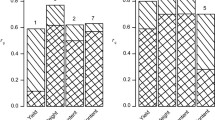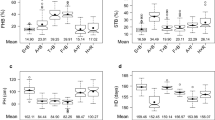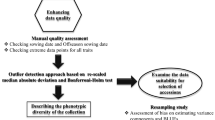Abstract
Robust predictions of genetic variances for important traits would facilitate greater genetic gains in plant breeding. Previous attempts to predict the genetic variance (\(\sigma_{\text{G}}^{2}\)) of traits in bi-parental breeding populations were inconsistent and context specific. The weakness of methods that consider the phenotypic distance, genetic distance, and relationship-based distance of pairs of parents, which we collectively term historical methods, stems from the fact that they do not explicitly model the segregation of the underlying genetic effects for a trait within a population. To address this issue, we propose the use of three modern methods made possible by the commonplace use of genomewide molecular marker data and genomic selection in modern breeding programs. These modern methods utilize both phenotypic and genotypic records to, in varying degrees, explicitly model the segregation of informative genomewide markers to predict \(\sigma_{\text{G}}^{2}\) in bi-parental breeding populations. In this study, we evaluate the accuracy of historical and modern methods to predict \(\sigma_{\text{G}}^{2}\) using 40 field-tested bi-parental barley breeding populations evaluated during 2003–2010 for Fusarium head blight severity. In general, the modern methods predicted the field-based estimates of \(\sigma_{\text{G}}^{2}\) more accurately than the historical methods. Specifically, the modern method that most explicitly models the segregation of informative genomewide markers, called ‘PopVar,’ was the most accurate \(\sigma_{\text{G}}^{2}\) prediction method.


Similar content being viewed by others
References
Bates D, Maechler M, Bolker B, Walker S (2014) lme4: Linear mixed-effects models using Eigen and S4. R package version 1.1-6. R Foundation for Statistical Computing, Vienna
Bernardo R (2013) Genomewide selection when major genes are known. Crop Sci 54(1):68–75
Bernardo R (2014) Genomewide selection of parental inbreds: classes of loci and virtual biparental populations. Crop Sci 54(6):2586–2595
Charcosset A, Lefort-Buson M, Gallais A (1991) Relationship between heterosis and heterozygosity at marker loci: a theoretical computation. Theor Appl Genet 81(5):571–575
Cleveland WS (1979) Robust locally weighted regression and smoothing scatterplots. J Am Stat Assoc 74(368):829–836
Close TJ, Prasanna BR et al (2009) Development and implementation of high-throughput SNP genotyping in barley. BMC Genom 10:582
Cohen J (1988) Statistical power analysis for the behavioral sciences, 2nd edn. Lawrence Erlbaum, Hillsdale
de los Campos G, Pérez P (2015) BGLR: Bayesian generalized linear regression. R package version 1.0.4. http://CRAN.R-project.org/package=BGLR
Durlak JA (2009) How to select, calculate, and interpret effect sizes. J Pediatr Psychol 34(9):917–928
Efron B (1979) Bootstrap methods: another look at the jackknife. Ann Stat 7(1):1–26
Endelman JB (2011) Ridge regression and other kernels for genomic selection with R package rrBLUP. Plant Genome 4:250–255
Falconer DS, Mackay TFC (1996) Introduction to quantitative genetics. Longman, England
Goodman M, Lasker G (1974) Measurement of distance and propinquity in anthropological studies. In: Crow J, Denniston C (eds) Genetic distance. Plenum Press, New York
Heffner EL, Jannink J-L, Sorrells ME (2011) Genomic selection accuracy using multifamily prediction models in a wheat breeding program. Plant Genome 4:65–75
Holland JB, Nyquist WE, Cervantes-Martińex CT (2003) Estimating and interpreting heritability for plant breeding: an update. In: Janick J (ed) Plant breeding reviews, vol 22. Wiley, New York, pp 9–112
Hung HY, Browne C, Guill K, Coles N, Eller M, Garcia A, Lepak N, Melia-Hancock S, Oropeza-Rosas M, Salvo S, Upadyayula N, Buckler ES, Flint-Garcia S, McMullen MD, Rocheford TR, Holland JB (2012) The relationship between parental genetic or phenotypic divergence and progeny variation in the maize nested association mapping population. Heredity 108:490–499
Jinks JL, Pooni HS (1976) Predicting the properties of recombinant inbred lines derived by single seed descent. Heredity 36:253–266
Lian L, Jacobson A, Zhong S, Bernardo R (2015) Prediction of genetic variance in biparental maize populations: genomewide marker effects versus mean genetic variance in prior populations. Crop Sci 55(3):1181–1188
Lorenz AJ, Smith KP (2015) Adding genetically distant individuals to training populations reduces genomic prediction accuracy in barley. Crop Sci 55(5). doi:10.2135/cropsci2015.02.0102
Lorenz AJ, Chao RE, Asoro F, Heffner EL, Hayashi T, Iwata H, Smith KP, Sorrels ME, Jannink J-L (2011) Genomic selection in plant breeding: knowledge and prospects. Adv Agron 110:77–123
Lorenzana RE, Bernardo R (2009) Accuracy of genotypic value predictions for marker-based selection in biparental plant populations. Theor Appl Genet 120:151–161
Massman J, Cooper B, Horsley R, Neate S, Dill-Mackey R, Chao S, Dong Y, Schwarz P, Muehlbauer GJ, Smith KP (2011) Genome-wide association mapping of Fusarium head blight resistance in contemporary barley germplasm. Mol Breed 27(4):439–454
Mather K, Jinks J-L (1982) Biometrical genetics, 3rd edn. Chapman and Hall, London
McMullen MD, Kresovich S et al (2009) Genetic properties of the maize nested association mapping population. Science 325(5941):737–740
Mohammadi M, Tiede T, Smith KP (2015) PopVar: a genome-wide procedure for predicting genetic variance and correlated response in bi-parental breeding populations. Crop Sci 55:2068–2077
Muñoz-Amatriaín M, Moscou MJ et al (2011) An improved consensus linkage map of barley based on flow-sorted chromosomes and single nucleotide polymorphism markers. Plant Gen. 4:238–249
Nei M (1974) A new measure of genetic distance. In: Crow JF, Denniston C (eds) Genetic distance. Plenum Press, New York, pp 63–76
Park T, Casella G (2008) The Bayesian lasso. J Am Stat Assoc 103(482):681–686
R Development Core Team (2013) R: a language and environment for statistical computing. R Foundation for Statistical Computing, Vienna. http://www-R-project.org
Riedelsheimer CF, Technow F, Melchinger AE (2012) Comparison of whole-genome prediction models for traits with contrasting genetic architecture in a diversity panel of maize inbred lines. BMC Genom 13:452
Rincent R, Laloë D, Nicolas S et al (2012) Maximizing the reliability of genomic selection by optimizing the calibration set of reference individuals: comparison of methods in two diverse groups of maize inbreds (Zea mays L.). Genetics 192(2):715–728
Sallam AH, Endelman JB, Jannink J-L, Smith KP (2015) Assessing genomic selection prediction accuracy in a dynamic barley breeding population. Plant Genome 8(1). doi:10.3835/plantgenome2014.05.0020
Souza E, Sorrels ME (1991) Prediction of progeny variation in oat from parental genetic relationships. Theor Appl Genet 82:233–241
Szűcs P, Blake VC, Bhat VR, Close TJ, Cuesta-Marcos A, Muehlbauer GJ, Ramsay LV, Waugh R, Hayes PM (2009) An integrated resource for barley linkage map and malting quality QTL alignment. Plant Genome 2:123–140
Technow F (2015) R package mvngGrAd: moving grid adjustment in plant breeding field trials. R package version 0.1.5
Tiede T, Mohammadi M, Smith KP (2015) PopVar: genomic breeding tools: genetic variance prediction and cross-validation. R package version 1.2.1
VanRaden PM (2008) Efficient methods to compute genomic predictions. J Dairy Sci 91:4414–4423
Zhong S, Jannink J-L (2007) Using quantitative trait loci results to discriminate among crosses on the basis of their progeny mean and variance. Genetics 177:567–576
Acknowledgments
We thank Ed Schiefelbein, Karen Beaubien, Guillermo Velasquez, and members of Dr. Ruth Dill-Macky’s lab for collecting disease data used in this work. We also thank Dr. Shiaoman Chao for generating the marker genotype data. This research was supported by USDA NIFA 2006-55606-16722, USDA NIFA 2011-68002-30029, USDA-ARS U.S. Wheat and Barley Scab Initiative Grant No. 59-0790-4-120, and the Minnesota Agricultural Experiment Station Small Grains Initiative.
Author information
Authors and Affiliations
Corresponding author
Electronic supplementary material
Below is the link to the electronic supplementary material.
11032_2015_390_MOESM1_ESM.tiff
Supplementary material 1 Fig. S1 Relationships between the \(\sigma_{\text{G}}^{2}\) predictor metric and \({\text{V}}_{{\widehat{\text{G}}}}\) for six prediction methods. The number of breeding populations (n) for PD is lower than the other five methods because only genotypes were available for some of the parents. As opposed to Figure 1, only breeding populations with a significant \({\text{V}}_{{\widehat{\text{G}}}}\) are considered (TIFF 60623 kb)
11032_2015_390_MOESM2_ESM.tiff
Supplementary material 2 Fig. S2 Relationship between μ sp and the number of progeny advanced across the 101 breeding populations whose parents were both included in the TP (TIFF 47822 kb)
11032_2015_390_MOESM3_ESM.tiff
Supplementary material 3 Fig. S3 Illustration of how to divide Figures 1 and S1 into quadrants for practical discussions (TIFF 48210 kb)
Rights and permissions
About this article
Cite this article
Tiede, T., Kumar, L., Mohammadi, M. et al. Predicting genetic variance in bi-parental breeding populations is more accurate when explicitly modeling the segregation of informative genomewide markers. Mol Breeding 35, 199 (2015). https://doi.org/10.1007/s11032-015-0390-6
Received:
Accepted:
Published:
DOI: https://doi.org/10.1007/s11032-015-0390-6




